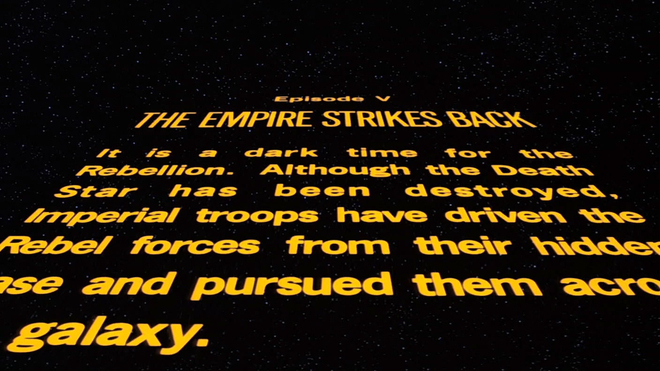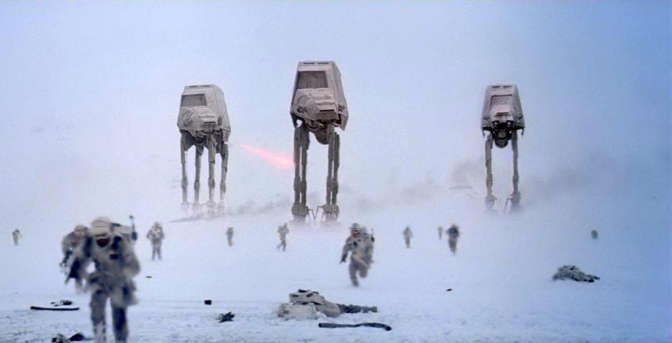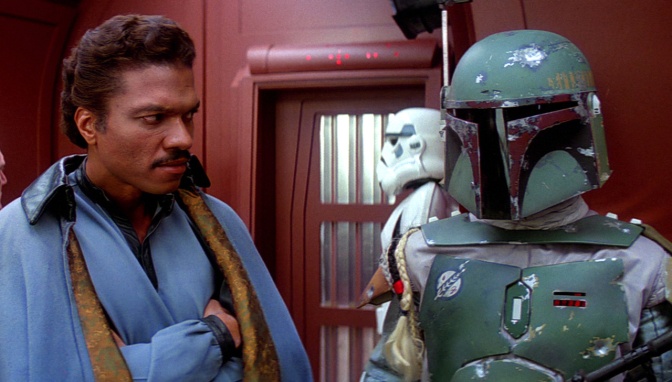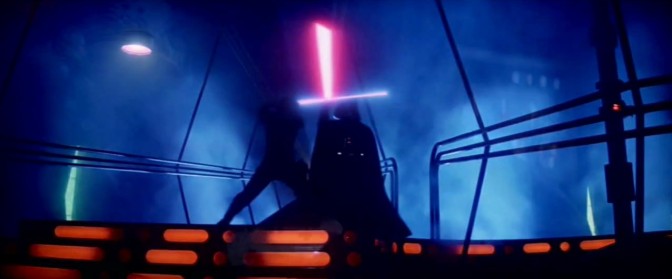As has been proven countless times over the history of cinema, creating a sequel to a successful movie is not an easy task. The fans want more of the first movie; the director and screenwriter want to blaze a new trail; while the studio execs want to increase the profit margin substantially. It’s that “bigger is better” mentality that so often cripples a sequel before it even begins, but when you talk what a sequel could and should be, there is only one film that comes up – The Empire Strikes Back.
And it’s easy to see why. With the world established by A New Hope, and the back story that leads us to this point succinctly filled in thanks to the introductory crawl, Empire dives straight into the action, reintroducing us to Luke, Han, Chewie and Leia in a matter of minutes. But what sets this apart from most sequels is that you don’t necessarily need to know any of this to enjoy it; the opening crawl recaps the last movie’s events, and the characters are introduced in such a way that you quickly learn who they are – Luke is a Jedi, Han is a renegade, and Leia is trying to hold this whole operation together.
Perhaps the biggest success of Empire though is raising the stakes from the moment the movie starts. We’re told straight away that despite the Death Star being destroyed, the Rebellion is under attack, and despite appearing to be secure on Hoth, the status quo is immediately broken by the arrival of Imperial Probe Droids. Of course this is a distraction, with Luke attacked and captured by a Wampa – within minutes of the movie starting, there’s a real chance that Luke and Han don’t make it to the end of Act 1; the stakes could not be higher.
The Wampa scene serves to reintroduce us to the Force, and indicates the progress Luke has made. While his successful rescue seems to revolve around a lot of sheer dumb luck on Han’s part (Hoth is a small place apparently…), the scene works wonderfully, reintroducing us to Obi-Wan through his Force Ghost, and setting events up for later in the movie. Although let’s quickly move on from Harrison Ford’s overacting when cutting up his Tauntaun.
While all this is going on, a never more menacing Darth Vader returns aboard his imposing Super Star Destroyer. The scenes aboard the SSD are some of the best in the franchise, with Vader mercilessly killing anyone who makes a mistake, but with the Imperial March theme they become unforgettable. If there was any doubt as to Vader’s villainy, it all disappears in the moments it takes to kill Admiral Ozzel.
The arrival of Vader signals the start of what is one of the highlights of the franchise – the Battle of Hoth. The battle not only serves to underline the absolute power of the Empire, but it also reminds us that this is still a fledgling Rebellion, and that when the opening crawl said they were being hunted, it was meant. The absolute destruction of Echo Base by the Empire is shocking in its aggression, and despite a few minor victories, we are shown how hopelessly outmatched they are. Without Luke, it is unlikely even a single AT-AT would have been taken down, and the panicked escape from Hoth just underlines the Empire’s stranglehold on the galaxy.
From the tension of the AT-ATs approaching, to the Snowspeeder’s being dispatched into the battle, to the sight of the Millennium Falcon escaping, everything about the battle is tonally perfect. In fact, it wouldn’t have felt out of place at the end of the movie, but instead acts as the set-up for everything to come.
From this point on, Star Wars enters new territory – we lose the established format from A New Hope of having a guide through the story, and splinter in two, cutting between between Luke’s trip to Dagobah, and the Millennium Falcon’s lengthy escape from Hoth. Ultimately these two arcs feed into the final act, and counter each other by keeping the action stakes high enough during a fair amount of exposition.
So let’s tackle Luke’s visit to Dagobah first, as it essentially paves the way for everything coming up. The arrival to Dagobah has always been a bit of a mystery to me – how exactly does Luke land on the doorstep of Yoda’s hut? Maybe you can explain it away with the Force, but it’s a curious, albeit necessary, plot point. Yoda’s introduction as a maniacal frog creature is also strange, but one that is ultimately explained when he converses with Obi-Wan through the Force. It’s a great moment, which speaks of a bond between the two, and begins to hint at the story behind Vader’s fall – Yoda initially refuses to train Luke as he is too old, much in the same way he does with Anakin.
These initial seeds of Luke’s true parentage are scattered throughout the Dagobah arc, and are underlined by cutting intermittently to Vader. These scenes are hugely notable for the entire movie, with us not only getting a glimpse of there being a man inside the suit, but also a first glimpse of the Emperor. Instantly we see Vader go from a leader, to a servant, indicating the sheer power at the Emperor’s disposal. We’re also given insight into Anakin Skywalker’s son being alive – while we’re not told explicitly that Vader is Anakin, his reaction, and the Emperor’s subsequent insistence of him knowing it to be true, give us a solid indication of a connection. It’s small, but something that feeds into the twist at the end.
The Dagobah training arc meanwhile gives us further insight into the Force, and while the Dark Side cave is ultimately more confusing than informative, it does show the power of the Force, something that is strengthened by Yoda’s retrieval of the X-Wing. When Luke leaves for Bespin, we’re given hints at the future, and hints at his past, which all feed into the next movie.
While all this exposition is being delivered, we’re treated to a thrilling and tense escape from Hoth with the crew of the Millennium Falcon. The asteroid sequence is superb, with the Empire stopping at nothing to track them down, while the cave sequence provides a humorous interlude in the face of certain death. That humour is prevalent throughout the second act of Empire, and shows the franchise starting to stretch its legs a little – from R2 swimming around Dagobah to the simple delight of Han getting hit on the head with a spanner, Empire intercuts the dark themes with simple slapstick humour.
The escape from the Empire also gives us a chance to reintroduce a minor plot point from A New Hope – that is Han’s bounty from Jabba. Mentioned early on, this comes back in a big way when Vader recruits numerous (brilliantly designed) Bounty Hunters to find Luke, which feeds into the introduction of Boba Fett and Slave I. While he is largely mute, and Slave I does very little, Boba’s introduction is a masterclass in providing just enough information for an audience to become attached, something that is also helped by an inspired design.
Which brings us to the final act of the movie; maybe even Empire’s crowning achievement. Not only is Bespin a wonderful location, but it also serves to tie-up all the disparate elements of Empire. Lando’s introduction sets up a tense moment early on, relieved through humour, yet there’s always an unease about Bespin. Despite a majestic score, nothing ever seems right about the place, fuelled by C3PO’s disappearance. Ultimately it is revealed, in another superb scene, that the Empire arrived shortly before the Falcon (thanks to Boba Fett); Vader’s “we’d be honoured if you joined us” moment is dripping in villainy, and is yet another standout moment for the character.
While the torture scenes only serve to underline this, the set-up of the carbonite chamber and Boba collecting on Jabba’s bounty inform the finale before Luke even arrives. It is clear that Vader has only one interest at this point, sowing further seeds of an unspoken connection. Han’s farewell in the carbonite chamber is superb, and is something of a shock twist given that Boba escapes Bespin with Han still frozen – how many other films would dare leave such an ambiguous fate to one of its main characters?
Of course the real finale is saved for the climactic showdown between Luke and Vader – far more intense than the lightsaber battle in A New Hope, this clash works on so many levels. His intro alone is worthy of note, with the now iconic “you are not a Jedi yet” instilling a real sense of fear in the audience. Vader’s manoeuvring of Luke into the carbonite pit is just the start, as Luke’s anger almost costs him his life. Vader too begins to lose his composure, hurling items at Luke in an attempt to disable him. Yet there’s always an underlying hint that Vader could destroy him at any time, yet chooses not to.
This builds across the battle, and ultimately ends in Vader unleashing his full power, disabling Luke almost at ease. Unable to be challenged, we get the first insight into the man behind Vader – he even goes so far as to suggest destroying the Emperor, hinting at the good still in him. Of course the big reveal follows this; what else can be said about it? As powerful today as it was back in 1980, Luke’s parentage sends shockwaves throughout the franchise.
All that’s left from here is to pick Luke up, escape from Bespin, and set things in motion for Episode VI. The final escape itself is a thrilling end, and we’re even treated to the first hint of Luke and Leia’s connection, although this is no more than a hint. The movie ends on a crushing cliffhanger – the Rebellion is on the brink of defeat, Luke has lost a hand, and Lando and Chewie are off on adventures unknown to save Han.
And that’s where we end. The Empire Strikes Back is a phenomenal piece of movie-making, and more importantly, story-telling. It’s a movie where the stakes could not be higher, and one that builds on what has come before in a new and interesting direction. It takes the ideas of A New Hope and crafts a new movie; it’s the same characters, but it’s fresh, it’s daring, it’s exciting. Yet the Empire has won the day and maybe the war – can the Rebellion recover in time?
Machete Order Review
As part of my rewatch, I’ll be using the Machete Order – that is IV > V > I > II > III > VI. The theory goes that this preserves the surprises and mystique of the world, so let’s see how it’s progressing.
At this stage, we’re very much maintaining the mythos that early audiences were presented with. We have a galaxy dominated by the Empire, and fought against by the Rebellion. We have Luke taking steps into a dormant world that was once crushed by Vader, with Yoda acting as our new guide. And we have a world of Bounty Hunters and smugglers operating within that.
Of course Empire’s big narrative change is the reveal of Vader as Luke’s father. This is something that is hinted at by Yoda and Obi-Wan on Dagobah, and also by the Emperor himself, yet we never get definitive confirmation. Luke appears to accept this begrudgingly, but the movie ends before that is delved into. Is Vader lying in an attempt to destroy the Emperor? Episode VI will surely hold the answers.




